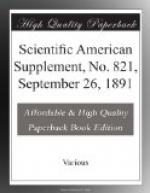of distilled tar, and every large factory uses it
at present. The roofing paper prepared with distilled
tar is perhaps most suitably called asphaltum paper,
as this has been used in its manufacture. It
possesses properties superior to the ordinary tar
paper, one of which is that immediately after its
manufacture, as soon as cold, it is dry and ready for
shipment; nor does it require to be kept in store
for a length of time, and it has also a good, firm
body, being as flexible and tough as leather.
It is very durable upon the roof, and remains flexible
for a long time. It is true that asphaltum papers
will always in a fresh state contain a small percentage
of volatile ingredients, which after a while make it
hard and friable upon the roof; but, by reason of its
greater percentage of resinous components, it will
always preserve a superior degree of durability and
become far less porous. One hundred parts by
weight absorb 140 or 150 parts by weight of coal tar.
A factory which distilled a good standard tar for
roofing paper recovered, besides benzole and naphtha,
also about ten per cent. of creosote oil, used for
one hundred parts raw paper, 176.4 partially distilled
tar. Experiments on a larger as well as a smaller
scale reduced this quantity to an average of 141.5
parts for one hundred parts raw paper. The weight
of sanded paper is very variable, as it depends altogether
upon the size of the sand grains. It may be stated
generally that the weight of the sand is as large
as that of the tarred paper.
The kinds of roofing paper saturated with other additions
besides coal tar form a separate class, in order to
neutralize the defects inherent in coal tar.
These additions were originally for the purpose of
thickening the paper and making it stiffer and drier.
The most ordinary and cheapest thickener was the coal
pitch. Although the resinous substances are increased
thereby, still the light tar oils remain to evaporate,
and the paper prepared with such a substance readily
becomes hard and brittle. A better addition is
the natural asphaltum, because it resists better the
destroying influence of the decomposition process,
and also, to a certain degree, protects the coal tar
in which it is dissolved. The addition of natural
asphaltum doubtless caused the name of “asphaltum
roofing paper.” Resin, sulphur, wood tar
and other substances were also used as additions;
each manufacturer kept his method secret, however,
and simply pointed out by high sounding title in what
manner his paper was composed. In most cases,
however, this appellation was applied to the ordinary
tar paper; the impregnating substance was mixed only
with coal pitch, or else a roofing paper saturated
with distilled tar. The costly additions, by
the use of which a high grade of roofing paper can
doubtless be produced, largely increased its price,
and on account of the constant fall of prices of the
article, its use became rather one of those things
“more honored in the breach than in the observance,”




